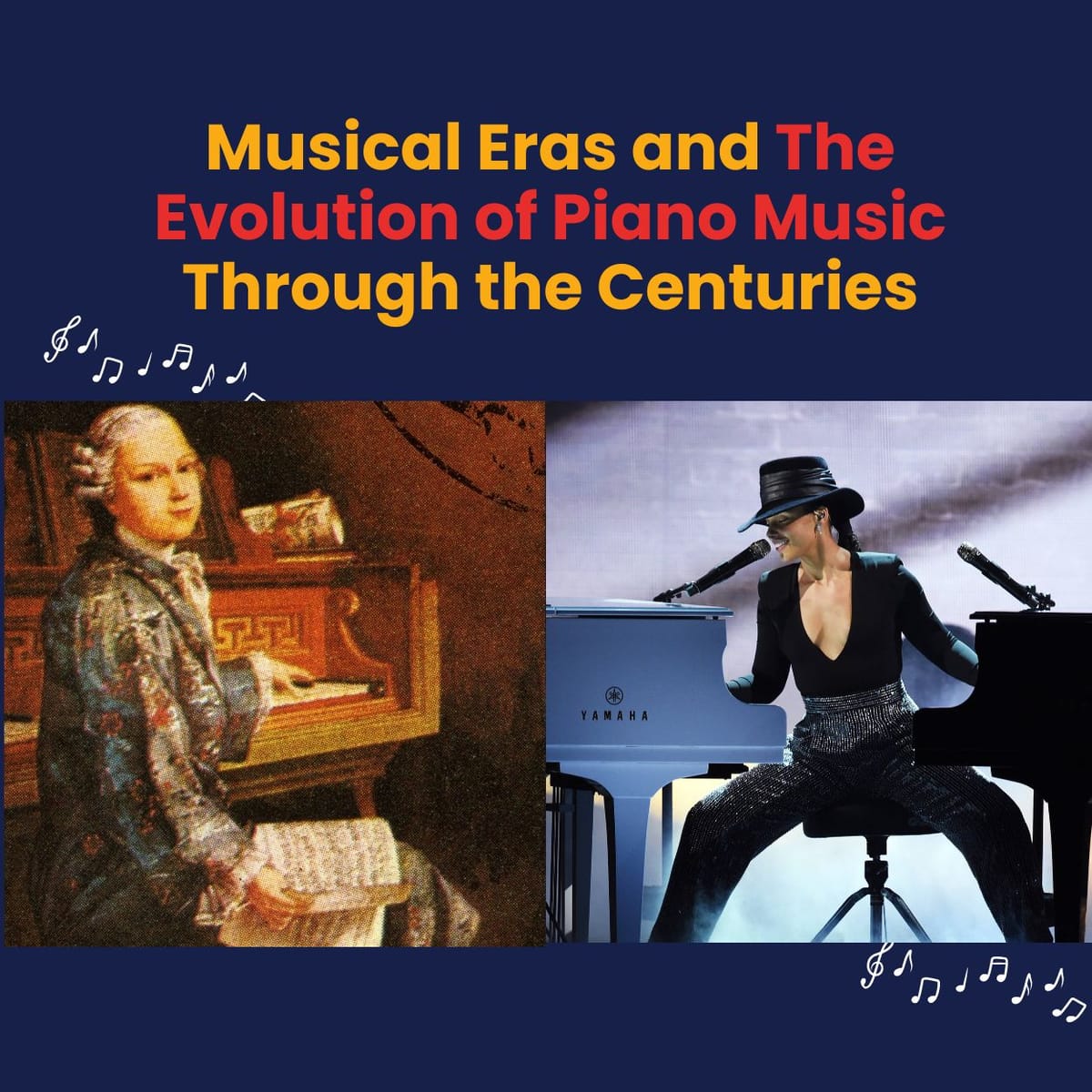
Table of Contents
Western music history is divided into seven different eras. Medieval (1150- 1400), renaissance (1400-1600), baroque era (1600-1750), classical era (1750-1820), romantic Era (1820- 1900), modern era (1900 onwards) and postmodern (1900 onwards).
These are divided based on many factors, but among them, the crucial ones are technology and materials available, philosophies, art, and historical events. In the case of the piano or the correct term, “piano forte”, the availability of technology and materials made an impact on the music written for the instrument. The earlier version of the instrument had limited usage of dynamics and it sounded more like a metallic plucked instrument like a harp or a lither. Thus the music in this period was written in a way that complemented the flaws of the instruments.
The following passage will briefly discuss the different musical eras and the evolution of piano music.
Different Musical Eras and the Evolution of Piano Music
Initially, the Church led Western Music. Like most societies, music, art, and dance were primarily led by religion. Western music has its roots in the hymns and gospels.
1. Renaissance Era
The beginnings of the piano came much later, taking inspiration from various percussive and string instruments. Some of the earlier versions of the pianos were the monochord, a simple instrument of one string in ancient Greece for tuning other instruments; and the polychord, a string instrument with multiple strings tuned to different pitches which were common during the medieval era. From the late period of the Renaissance, these instruments evolved further into a Clavichord and a Harpsichord.
2. Baroque Era
The piano forte music that is popularized in the current times, has its start during the baroque era with Johann Sebastien Bach leading as the prominent composer of this time. The other well-known composers were George Frederic Handel, Antonio Vivaldi, Henry Purcell, and Domenico Scarlatti. Bach’s Prelude in C major is a popular music of this period. Most piano beginners, after a few months into the lessons, can try this music. It is beautiful in its simple arrangements and gentle progressions. In fact, there is a saying that the Baroque era began and ended with Bach.
3. Classical Era: The Invention of Piano
Bartolomeo Cristofori is considered to be the inventor of the Piano in the early seventeenth century. His piano was the first that displayed a range of dynamics. Thus the name Piano forte, an instrument that can be soft and loud.
With his pianos, Mozart was able to experiment with expressions whereas Beethoven dealt with the depths of emotions on the instrument. The music of the early Classical eras was similar to those in Baroque except there were more dynamic ranges which brought colors to the sounds and tones. And this is evident in Mozart’s or Haydn’s music as the structure and progression of notes are similar to those during the baroque but there is the availability of dynamics of piano and forte that allowed these composers to experiment, even within the rigidity and confines of rules of compositions as many composers had to abide by their patronage for their livelihood.
Later in the seventeenth century, Beethoven broke those confinements, be it in the rules of compositions or the performance. He did not conform to the structure of the music, but rather the capability of the instrument. His temperamental personality shone in his music and as stated before, he used every bit of dynamic range possible, be it from pianississimo (ppp) to fortississimo (fff) with his sudden accented hit to gentle piano staccato. Though he lacked the patronage of nobility due to his eccentricities, he paved the way for composers like Chopin, Debussy, Ravel, and many more with aspirations to go beyond the limits of structures.
4. Romantic Era: Rise of Impressionism
This is evident in Chopin’s music, where his nocturnes displayed the ability of the piano to sound like a Harp. He was able to experiment with different sounds around us, be it other instruments or even animals, and interpret them on the piano. Similarly, Debussy and Ravel brought the impressionist painter Monet's art into music. They were inspired by different paintings of the time, including van Gogh’s Starry Night. In fact, Debussy, Satie, and Ravel were often called impressionists.
5. Modern Music
Finally, modern music is divided into two parts, modern and postmodern. By this time, musicians had the means and opportunities to travel around the world. Many of Debussy's works were inspired by the oriental scales during his travels to Asia. He also experimented with Rag style and Cake Walk. It is challenging to box music to a part of the world because by this time musicians from far and wide have taken their life experiences and journey in their music, be it Bartok’s influences of the Romanian Gypsies and countryside or Tschaikovsky’s inspiration from folk tales and songs. And of course, Scott Joplin was among the first African American musicians who drew the music works with his Ragtime and Cake Walks.
6. Postmodern Music
The postmodern period paved the way for too many new genres like Jazz and Blues where there have been inspirations from the African and Caribbean beats or the Ragas of Hindustani music. Postmodern music burst the bubble of world music. Postmodern music has many genres and it is no longer confined to the instruments or structures of compositions, rather it has more to do with moods and emotions.
Written by~
Dini Siregar,
Piano & Keyboard SME
